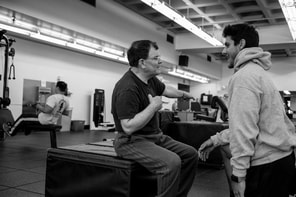 I just received an email from personal trainer, that has a new client that has autism, asking for exercise tips that would enable him to train his client to the best of his ability. Here are some things to remember when training an individual with autism: 1. Program design process stays the same - People are looking for a personal trainer because they are seeking something a little extra in their exercise routine. They want individual attention to help them meet their fitness goals, something that they cannot get in a group fitness class or in a school's P.E. class. They all will come to you with different reasons for wanting a personal trainer and it is your job to create a program for them that is INDIVIDUALIZED to their needs and goals. Your program design process is the same for all clients, neurotypical or autistic. 2. Variety in communication - Individuals with autism are often very literal in their ways of thinking, so it is important that you communicate in a very clear, concise manner when describing the workout and giving instructions about how to perform the exercises. These instructions should include oral instruction accompanied by visual instruction as well. I will make a list of the exercises that we are going to perform during the workout, demonstrate the exercise while giving oral instruction, and then do the exercise along with my client. Depending on my client's needs, I may also break down each exercise in a 3 step picture sequence along with a visual countdown of repetitions remaining. Your client may also have processing delays. Make sure to give them time to process the information that you are giving them and be patient. Eye contact may be limited or non existent as well, and that is OK! Here is a slide from Karla Fisher, a local autistic adult, that that explains why eye contact can be difficult and lead to shut down. http://on.fb.me/1k0JFa1 Be precise, clear, and ready to communicate in a variety of ways depending on your client's needs. 3. The weight room sensory experience - Weight rooms can be a living hell for an autistic individual, so LISTEN to your client. Many of our clients have sensory issues and experience the world around them very differently than their neurotypical peers. Loud sounds, strong smells, too many people can all lead to a negative experience. If your client says that it is too loud or that they are feeling anxious because of the crowd, then take the workout to a different room or outside if it is a nice day. You need to earn their trust and respect before you can try and gradually stretch their comfort zones. They might not understand why their body acts in a certain way while exercising. "Ryan, my heart feels like it's coming out of my chest." "My legs, they feel weak." "My legs feel like Jell-O." "My arms feel like they are burning." These are all things that I have had clients tell me. These are all physical sensations that we experience from exercising. Listen to your clients and explain how their body works and why they are feeling like that. Tell them that their heart rate increases during exercise because of your body's need to increase blood flow. Explain to them how to calculate their maximum heart rate and find their target heart rate. You are not only a personal trainer, but a teacher as well. Teach your clients how to exercise and take care of their bodies, but also teach them how their bodies work and why they are experiencing the physical sensations. DIFFERENT NOT LESS When training any client you must address their individual needs and goals. With an autistic client, those needs may include communication, processing, and sensory differences compared to your neurotypical clients. However, their bodies and muscles still work the same. There is a saying, "If you have met ONE person with autism, then you have met ONE person with autism." Every one of your clients will have different needs. It is your job to be able to listen to those needs and help them get their body moving and help them live a healthy lifestyle. The above tips may or may not apply to your client, but I hope they are useful. Remember that there are no magic exercises for training this population, just a need for equal respect and open ears.
0 Comments
Leave a Reply. |
About the AuthorRyan Lockard, CSCS*D, CSPS*D is the Founder and CEO of Specialty Athletic Training. He is accredited by the National Strength and Conditioning Association (NSCA) as a Certified Strength and Conditioning Specialist and a Certified Special Populations Specialist. Lockard is a member of the board of directors for the Autism Society of America and the advisory board for the NSCA Oregon chapter.
Archives
November 2023
|

 RSS Feed
RSS Feed